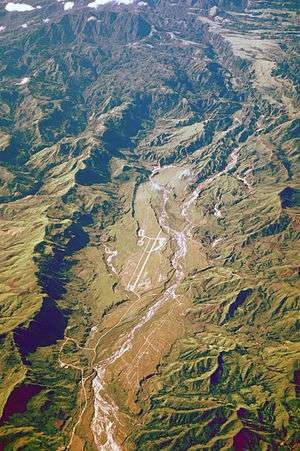Crow Valley Range Complex
| Crow Valley Bombing and Gunnery Range | |
|---|---|
.svg.png) Crow Valley Range Complex Crow Valley Range Complex (Philippines) | |
|
An aerial view of the mock airfield at Crow Valley | |
| Coordinates | 15°14′20.27″N 120°22′2.03″E / 15.2389639°N 120.3672306°E |
| Type | Bombing range |
| Site information | |
| Controlled by | Armed Forces of the Philippines |
The Crow Valley Bombing and Gunnery Range (IATA: RPXC) or Crow Valley Gunnery Range, and presently Tarlac Military Testing Ground, was the main bombing range of the United States Armed Forces in the western Pacific, and by the Armed Forces of the Philippines. Crow Valley is located in Camp O'Donnell in Tarlac, The Philippines. The 42-mile facility is located approximately 14 miles from Clark Air Base and is primarily used for aerial combat training, which include bombing and strafing practice, as well as ground unit maneuver and live fire exercises.[1]
History
Crow Valley was a component facility of Clark Air Base during the American presence in the Philippines. The facility was used extensively by the US 13th Air Force. It came to prominence during Cope Thunder exercises by forces from the Philippines, Canada, United Kingdom, Japan, New Zealand, Australia, Thailand and the Republic of Singapore during the 1970s.
Security at Crow Valley was the responsibility of the Security Police assigned to the 3rd Tactical Electronic Warfare Training Squadron (3rd TEWTS) based at Camp O'Donnell and combined Air Force Security Policemen and local DoD Civilian Guards.
Crow Valley was home to the 6009th Security Police Training Squadron (SPTS). While headquartered at Clark Air Base as an attached unit of the 3rd Security Police Group, the 6009th SPTS was responsible for conducting Air Base Ground Defense (ABGD) Training at their facility at Crow Valley. This training program was known in the Air Force as "Commando Warrior." Security Police units from throughout Asia and the Pacific would come to Crow Valley for two weeks of intense jungle warfare style training focused on the techniques necessary to protect an air base in a foreign country (aka The Republic of Gunderstand). This training facility was also the site of the Air Force Office of Special Investigations' "Commando Crow" program, training agents in tactical counterintelligence. These programs were active at this location throughout the 1980s.
The 1961st Communications Group, Operating Location Delta (OL-D) was responsible for communications support on the range. This included 4 MRC-108 Communication Jeeps, Air Traffic Control radios at Alpha Control on Camp O'Donnell and sights downrange including the Crow Valley Control Tower. Also maintained were the Strafe Scoring System and the Laser Target Designator Scoring System (LTDSS) located on the range and remoted to the Crow Valley Control Tower.
Description
The 17,814-hectare facility featured an airfield as well as sophisticated electronic warfare installations, including advanced radar and radar jamming equipment and even a Russian surface-to-air missile installation.[2] However, these facilities have been buried by pyroclastic flows during the 1991 Pinatubo explosion, and lahar thereafter.
The facility no longer has any of the aforementioned features. There is a small circular bullseye in the wash that is nearly invisible from medium altitude bombing.
Current status
At present, the facility is used occasionally for practice by the Armed Forces of the Philippines. It is also used as base camp for trails going to Mount Pinatubo when not in use. Crow Valley is also at times called the Tarlac Military Testing Ground.
In recent news, Crow Valley was also laid claim by some 508 Aeta families as ancestral domain. The Department of National Defense has rejected the claim.[2] After the 1991 Pinatubo explosion, and the turn over of the US military facilities, Pres. Fidel Ramos announced Proclamation No. 163 (1993) where Crow Valley was specifically exempted from the coverage of the Bases Conversion Development Authority (BCDA), and is primarily reserved for the use of the Armed Forces and the Defense Department.[3]
Crow Valley not only serves the needs of the Philippine Armed Forces, but also hosts as one of the venues of the BALIKATAN Joint Military Exercises.[4]
References
See also
External links
| Wikimedia Commons has media related to Crow Valley. |
- Inheritors of the Earth: The Human Face of U.S. Military Contamination at Clark Air Base, Pampanga, Philippines
- US bombing range plan for NT
